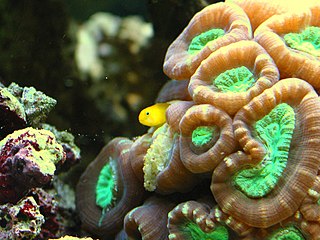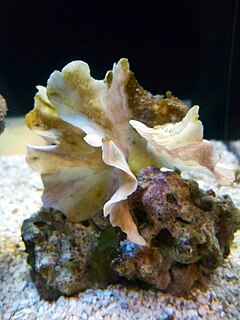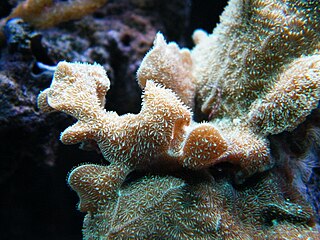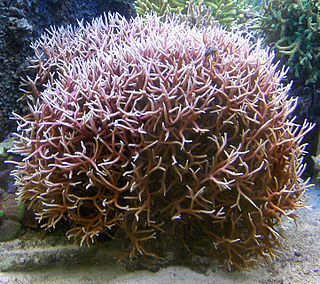
Corals are marine invertebrates within the class Anthozoa of the phylum Cnidaria. They typically form compact colonies of many identical individual polyps. Coral species include the important reef builders that inhabit tropical oceans and secrete calcium carbonate to form a hard skeleton.

A reef aquarium or reef tank is a marine aquarium that prominently displays live corals and other marine invertebrates as well as fish that play a role in maintaining the tropical coral reef environment. A reef aquarium requires appropriately intense lighting, turbulent water movement, and more stable water chemistry than fish-only marine aquaria, and careful consideration is given to which reef animals are appropriate and compatible with each other.

A marine aquarium is an aquarium that keeps marine plants and animals in a contained environment. Marine aquaria are further subdivided by hobbyists into fish only (FO), fish only with live rock (FOWLR), and reef aquaria. Fish only tanks often showcase large or aggressive marine fish species and generally rely on mechanical and chemical filtration. FOWLR and reef tanks use live rock, a material composed of coral skeletons harboring beneficial nitrogen waste metabolizing bacteria, as a means of more natural biological filtration.

Fire corals (Millepora) are a genus of colonial marine organisms that exhibit physical characteristics similar to that of coral. The name coral is somewhat misleading, as fire corals are not true corals but are instead more closely related to Hydra and other hydrozoans, making them hydrocorals. They make up the only genus in the monotypic family Milleporidae.

Duncanopsammia is a monotypic genus of stony corals. It is represented by the single species, Duncanopsammia axifuga, commonly called whisker coral, duncanops coral, or simply duncan coral. Individual polyps are fairly large with round skeletal bases (corallites) 10–14 millimetres (0.39–0.55 in) in diameter and larger central discs from which multiple tentacles radiate; the polyps form a structure branching at irregular intervals to form a large colony.

Pocillopora meandrina, commonly known as cauliflower coral, is a species of coral occurring in the Indo-Pacific and Pacific oceans. This coral lives in shallow reef environments.

Coral aquaculture, also known as coral farming or coral gardening, is the cultivation of corals for commercial purposes or coral reef restoration. Aquaculture is showing promise as a tool for restoring coral reefs, which are dying off around the world. The process protects young corals while they are most at risk of dying. Small corals are propagated in nurseries and then replanted on the reef.

Galaxea fascicularis is a species of colonial stony coral in the family Euphylliidae, commonly known as octopus coral, fluorescence grass coral, galaxy coral among various vernacular names.

Porites lobata, known by the common name lobe coral, is a species of stony coral in the family Poritidae. It is found growing on coral reefs in tropical parts of the Indian and Pacific Oceans.

Melithaea ochracea is a species of colonial soft coral in the family Melithaeidae, commonly known as knotted fan coral. It grows in tree-like fans on coral reefs in the South China Sea. It is used in the jewellery industry under the name red spongy coral.

Caulastraea is a genus of stony corals in the family Merulinidae. Species of Caulastraea are commonly found in the aquarium trade under the names candy cane coral or trumpet coral.

Pavona is a genus of colonial stony corals in the family Agariciidae. These corals are found in shallow waters in the Indo-Pacific region.

Pavona cactus, the cactus coral, potato chip coral or leaf coral, is a species of colonial stony coral in the family Agariciidae. This coral is found in shallow waters on reefs and in lagoons in tropical parts of the Indo-Pacific region.

Catalaphyllia is a monotypic genus of stony coral in the family Euphylliidae from the western Pacific Ocean. It is represented by a single species, Catalaphyllia jardinei, commonly known as elegance coral. It was first described by William Saville-Kent in 1893 as Pectinia jardinei.

Anomastraea is a monotypic genus of corals in the family Coscinaraeidae. It is represented by a single species, the crisp pillow coral.

Seriatopora hystrix is a species of colonial stony coral in the family Pocilloporidae. It forms a branching clump and is commonly known as thin birdsnest coral. It grows in shallow water on fore-reef slopes or in sheltered lagoons, the type locality being the Red Sea. It is native to East Africa, the Red Sea and the western Indo-Pacific region. It is a common species and the International Union for Conservation of Nature has assessed its conservation status as being of "least concern".

Platygyra daedalea, sometimes known as the lesser valley coral, is a colonial species of stony coral in the family Merulinidae. It occurs on reefs in shallow water in the Indo-Pacific region. It is a common species and the International Union for Conservation of Nature has assessed its conservation status as being of "least concern".

Heliofungia actiniformis is a solitary species of mushroom coral, a large polyp stony coral in the family Fungiidae. This coral is found in shallow water in the Indo-Pacific region. It is a zooxanthellate species. It is a popular coral in the reef aquarium trade; wild populations are threatened by disease, climate change, and over-collecting, and the species is considered vulnerable by the IUCN.


















